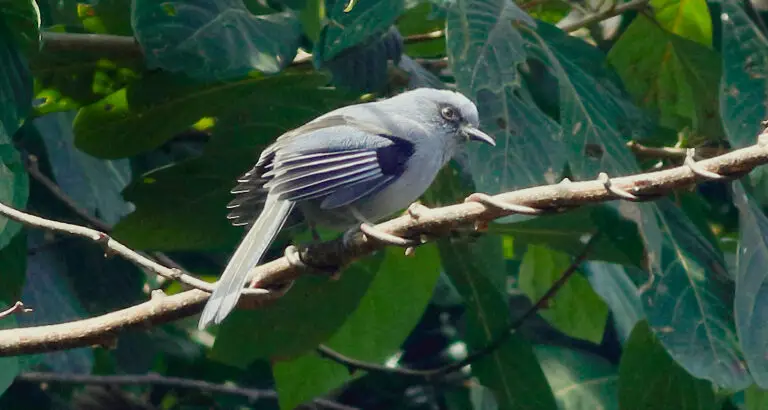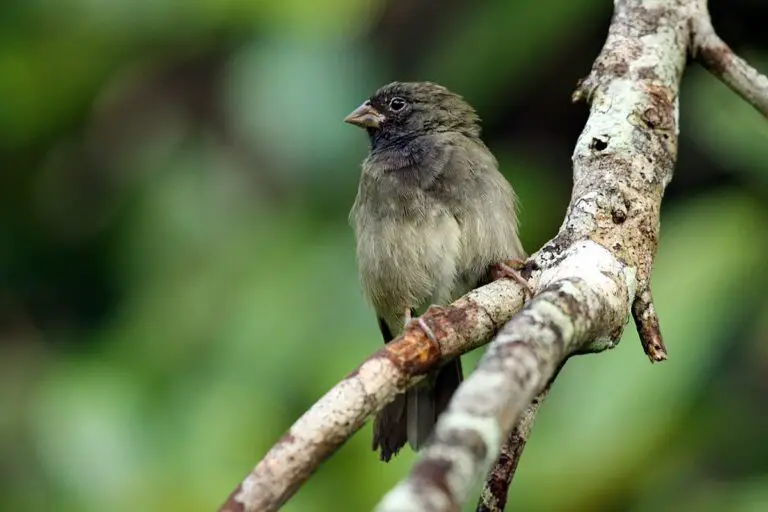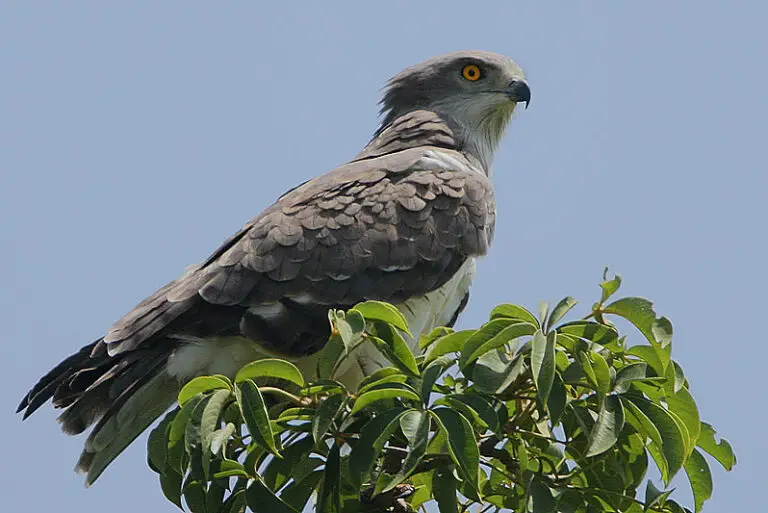Jacana (Jacanidae)
“The jacana has the ability to swim underwater”
The Jacana, a fascinating bird known for its distinctive long toes adapted for walking on floating vegetation, falls under the following.
Scientific Classification
- Kingdom: Animalia
- Phylum: Chordata
- Class: Aves
- Order: Charadriiformes
- Family: Jacanidae
- Genus: Jacana Brisson
- Scientific Name: Jacanidae
Conservation Status: Least Concern
Jacana can be found in various locations across the globe, including Africa, Asia, Central America, North America, Oceania, and South America.
Jacana facts:
- Prey: The Jacana sustains itself on a diverse diet including insects, snails, worms, crabs, fish, mollusks, and seeds.
- Fun Fact: Despite being primarily terrestrial, the jacana possesses the surprising ability to swim underwater.
- Estimated Population Size: In the wild, Jacana populations are estimated to be in the millions.
- Biggest Threat: The most pressing threat to Jacanas is habitat loss, primarily due to human activities.
- Most Distinctive Feature: Jacanas are instantly recognizable by their long legs and feet, which are well adapted for walking on floating vegetation.
- Other Name(s): Jacanas are also known as Lilly trotters or lotus birds.
- Wingspan: On average, Jacanas boast a wingspan of around 20 inches.
- Incubation Period: Jacana eggs typically hatch after a period of 22-28 days of incubation.
- Habitat: These birds prefer wetland environments for nesting and foraging.
- Predators: Jacanas face threats from a variety of predators including otters, turtles, crocodiles, snakes, birds of prey, and fish.
- Diet: Jacanas are omnivorous birds, meaning they consume both plant and animal matter.
- Type: Jacanas are categorized as birds.
- Common Name: The common name for these birds is “Jacana.”
- Number Of Species: There are a total of 8 known species of Jacanas.
- Location: Jacanas inhabit regions across Asia, Africa, Australia, and Central and South America.
- Average Clutch Size: Jacana nests typically contain an average of 3 eggs.
- Nesting Location: These birds build their nests on floating islands within wetland habitats.
- Age of Molting: Jacanas typically begin molting around 50-60 days after hatching.
- Physical Characteristics:
- Color: Jacanas display a range of colors including brown, yellow, red, black, white, and green.
- Weight: Jacanas vary in weight, typically ranging from one to nine ounces.
- Height: The height of Jacanas typically ranges from six to 12 inches.
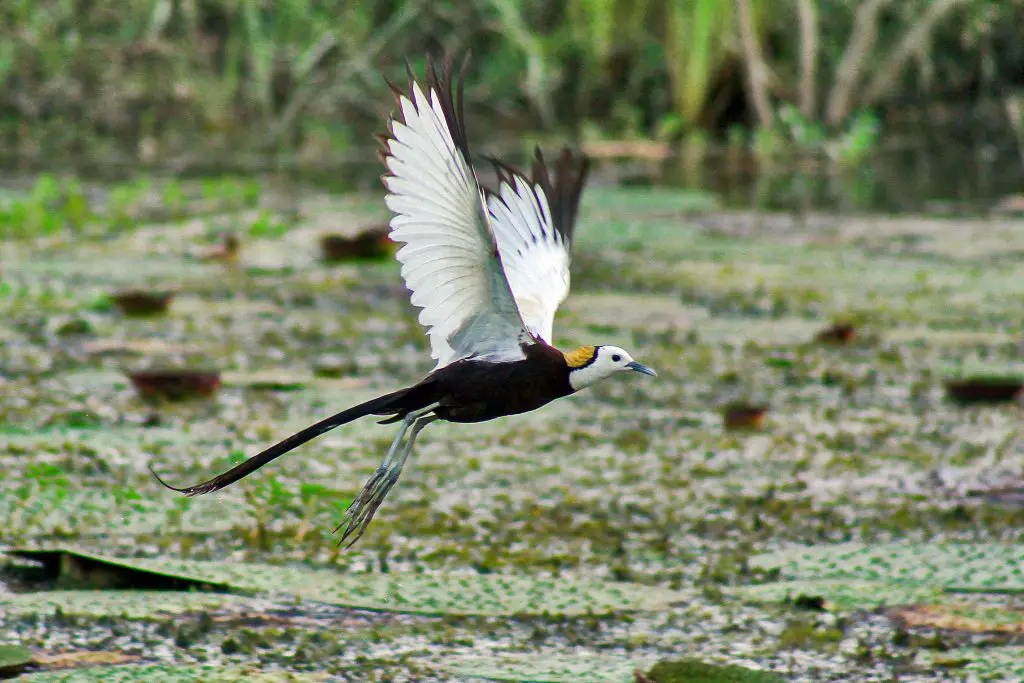
“The jacana, known as the great swimmer and diver, belongs to a family of vibrant and long-legged water birds thriving in the lush tropical wetlands across the globe. Comprising eight documented species, with an additional four species recorded solely through fossils, these birds are grouped within an order that encompasses other aquatic avians like waders, gulls, and auks. In this article, we’ll delve into fascinating insights about the identification, behavior, and dietary habits of this remarkable bird.”
4 Amazing Jacana Facts!
- Mutual Relationship with Capybara: The wattled jacana, found in South America, engages in a fascinating mutual relationship with the capybara. It assists the capybara by picking ticks directly off its body, showcasing a unique symbiotic bond between the two species.
- Tail Variations: While most species of jacanas exhibit short or even non-existent tails, the pheasant-tailed jacana stands out as a remarkable exception. This species boasts an elongated tail, particularly during the breeding season, adding to its distinctiveness among its relatives.
- Temporary Molting Periods: The African jacana experiences temporary molting periods, during which it undergoes a significant change in its plumage. During these phases, the bird loses its ability to fly altogether, highlighting an intriguing aspect of its life cycle.
- Apt Naming: The name “jacana” is aptly given to these birds, as it reflects their unique characteristics and behaviors. From their distinctive appearance to their fascinating ecological interactions, jacanas continue to captivate researchers and enthusiasts alike with their intriguing traits.
Where to Find the Jacana
Jacanas thrive in warm tropical regions worldwide, spanning continents such as Africa, southern Asia, Australia, Mexico, Central America, and South America. Occasionally, these adaptable birds venture as far north as the United States. Their specialized adaptations suit them perfectly to the wetland habitats they prefer, including swamps, marshes, lagoons, and shallow lakes.
Nests
The female jacana takes on the task of constructing a modest nest, utilizing whatever plant materials are at hand on the floating islands where they typically reside.
Scientific Name
The scientific name of the jacana family is Jacanidae, derived from the name of the bird itself. Among the eight known species, they are classified into six distinct genera.
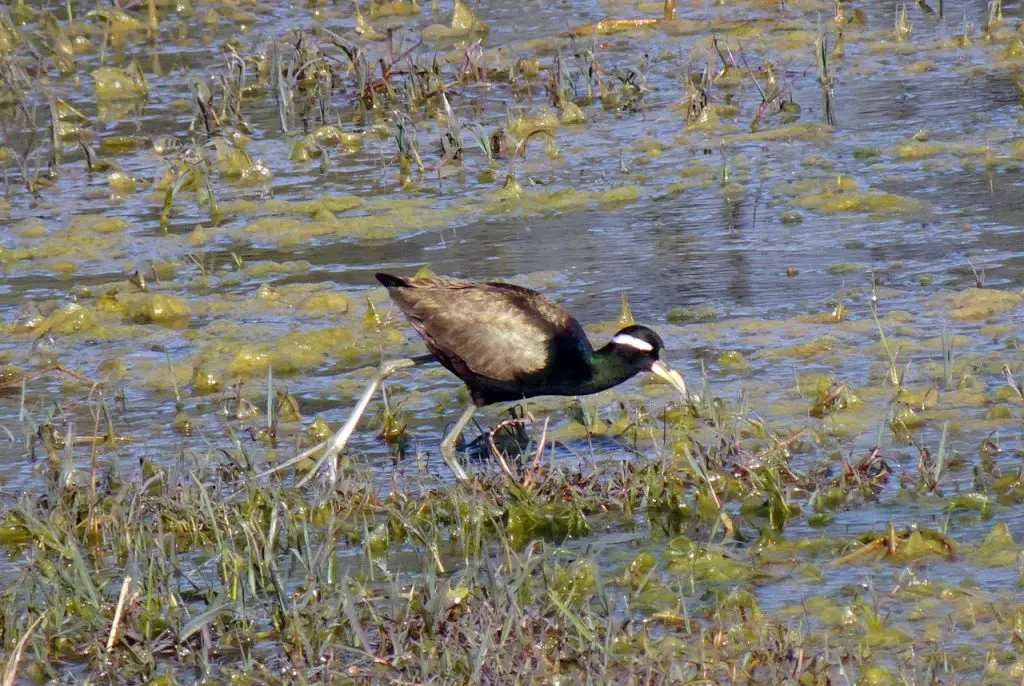
Size, Appearance, and Behavior
The jacana, a medium-sized bird standing between six and 12 inches tall, boasts distinctive features crucial for identification, notably its elongated, slender legs resembling twigs and branches. These birds exhibit a diverse array of colors, ranging from brown and cinnamon to white and black, often accentuated by flashes of yellow or green in their flight feathers. Despite females being larger than males, their plumage remains nearly identical, presenting a challenge for distinguishing between the sexes. Some species of jacanas sport small red wattles or crowns near the beak, adding to their visual intrigue.
Adapted seamlessly to their wetland habitat, jacanas utilize their long legs and feet to gracefully traverse lily pads and other floating vegetation without sinking. In the face of danger, they adeptly submerge themselves underwater for extended periods, with their bill protruding above the surface to facilitate breathing. While not known for robust, sustained flights, they glide effortlessly for short distances above the water’s surface. Their plumage serves as effective insulation, ensuring warmth and comfort in their aquatic environment.
Jacanas exhibit a relatively straightforward social structure, primarily foraging and hunting alone but congregating during breeding seasons. Highly vocal creatures, their communication repertoire includes a diverse range of sounds, from soothing chirps to alarm calls. These vocalizations serve various purposes, from nurturing chicks to alerting others to potential threats, reflecting the intricacies of jacana social dynamics.
Types
Typically there are eight jacana species:
- African Jacana: This species stands out with its bronze plumage, dark wingtips, and vibrant blue beak. It holds the title of the largest among jacana species, weighing up to 9.1 ounces and measuring over 12 inches in length.
- Bronze-winged Jacana: Found in Southeastern Asia, this bird displays dark bronze plumage with an emerald sheen and a yellow-green beak. It’s slightly smaller than the African Jacana, reaching lengths of around 11 inches.
- Comb-crested Jacana: Characterized by a distinctive fleshy pink wattle on its head, a white face and throat, and dark dorsal feathers, this species also features dark stripes extending from its eyes. It sports a short dark beak and white tail feathers.
- Lesser Jacana: With mottled plumage, this species inhabits various regions across western, central, eastern, and southern Africa.
- Madagascar Jacana: Found in eastern Madagascar, this wader showcases a head that’s often black or mottled white and black on the upper half, transitioning to black on the lower half, with dark bronze plumage.
- Northern Jacana: Inhabiting Central America and the Caribbean, this species boasts a black head and neck, a rich russet upper body, a yellow-tipped bill, and pale green flight feathers. It reaches lengths of about 8 inches.
- Pheasant-tailed Jacana: Recognized by its white head, slender neck lined with yellow feathers, and white wing feathers contrasting with dark brown plumage, this species migrates extensively across the Middle East to East Asia. Its distinctive feature is its elongated tail arching gracefully.
- Wattled Jacana: Residing in the Caribbean and Latin America, this wader stands out with its black and russet plumage, yellowish-green flight feathers, and a yellow beak blending into a fleshy plate on its head. It grows up to 9 inches or slightly longer.
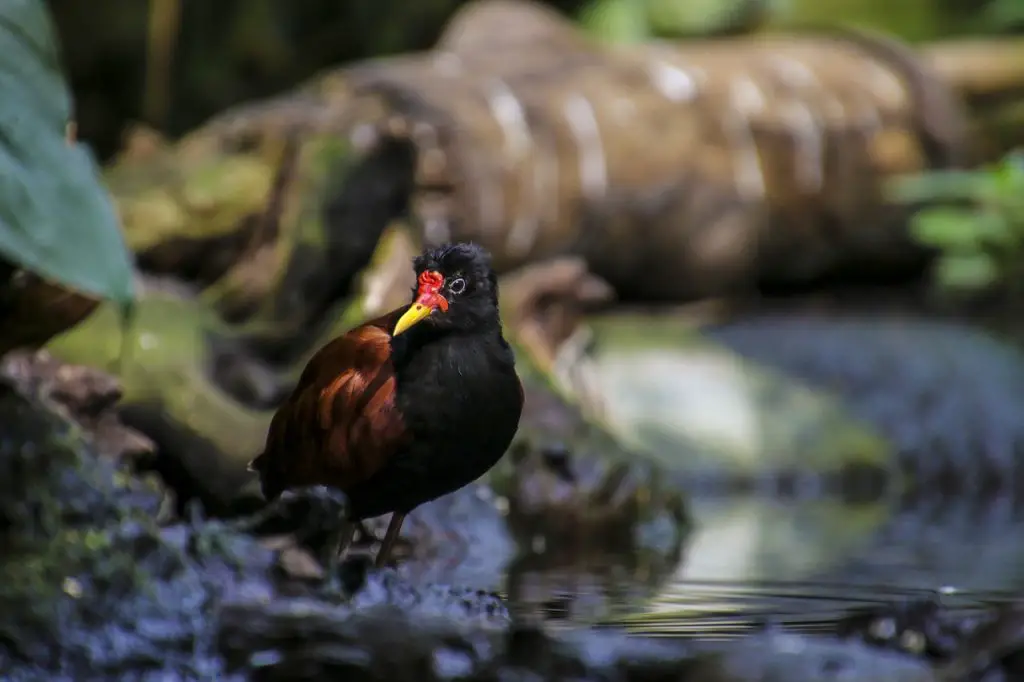
Evolution and Classification
The Jacanidae family encompasses six genera, each housing distinct species of jacanas:
- Actophilornis: This genus includes the African jacana (Actophilornis africanus) and the Madagascar jacana (Actophilornis albinucha).
- Jacana: The genus Jacana comprises the northern jacana (Jacana spinosa) and the wattled jacana (Jacana jacana).
- Hydrophasianus: This genus is represented by the pheasant-tailed jacana (Hydrophasianus chirurgus), notable for its possession of six neck vertebrae, a unique feature among jacana species.
- Irediparra: The comb-crested jacana (Irediparra gallinacea) belongs to this genus.
- Metopidius: The bronze-winged jacana (Metopidius indicus) is the sole member of this genus.
- Microparra: This genus includes the lesser jacana (Microparra capensis).
Fossil evidence of this fascinating family of waders, known for their distinctive social organization and elongated digits, has been unearthed in Africa and the Americas. The oldest specimen, discovered in Egypt, dates back to the Oligocene period, approximately 23 to 34 million years ago. Additionally, fossils found in Florida provide evidence of their presence during the Pliocene era, around 2.59 to 5.33 million years ago.
Diet
The jacana, being an omnivorous bird, maintains a diverse diet, primarily focusing on small insects. However, it supplements its insect consumption with a variety of other foods including snails, worms, crabs, fish, mollusks, and seeds. To procure its sustenance, the jacana employs a combination of its beak, toes, and claws, adeptly maneuvering through aquatic vegetation in search of its preferred prey.
Predators, Threats, and Conservation Status
The jacana faces predation from various animals including otters, turtles, crocodiles, snakes, birds of prey, and large fish. Despite these threats, jacanas have developed strategies for evasion, such as running away or hiding underwater when sensing danger. Additionally, certain species like the wattled jacana of the Americas possess sharp claws or spurs on their elbow wings, providing an additional defense mechanism. Furthermore, the bare, fleshy area on the front of their bodies may reflect light, aiding in camouflage.
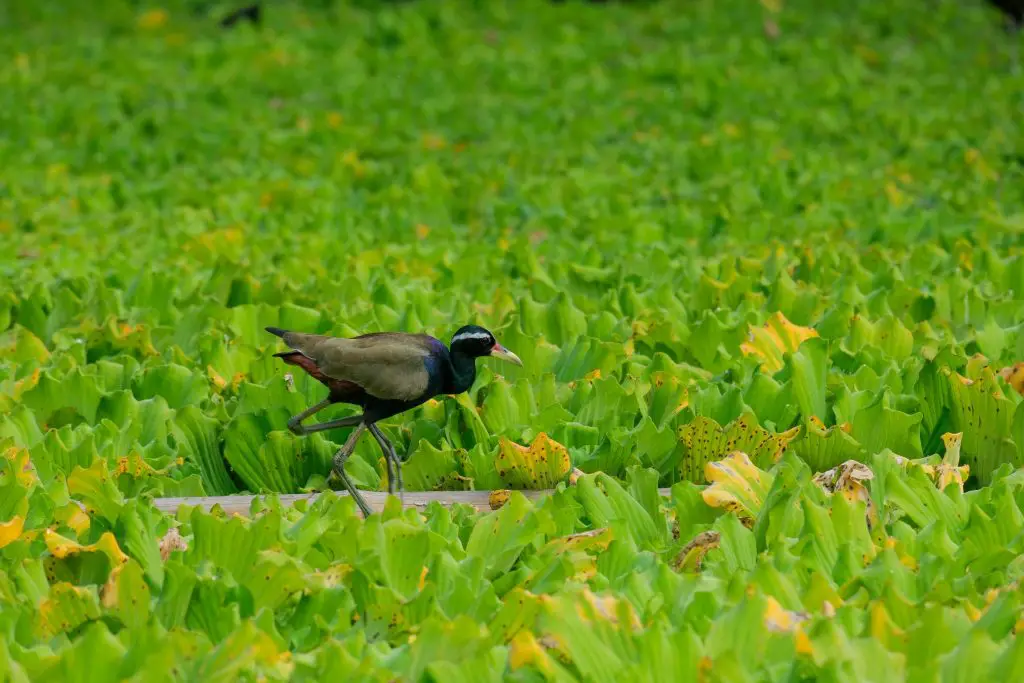
Reproduction, Young, and Molting
The gender role reversal observed in jacana birds, particularly exemplified by species like the Pheasant-Tailed Jacana, is a fascinating phenomenon in avian behavior. In contrast to the typical polygamous arrangements seen in many bird species where males court multiple females, jacana females establish and maintain harems comprising up to four males at a time.
Within the female’s expansive territory, which can span up to two football fields in length, all resident males are considered part of her exclusive mating group. This unique arrangement allows the female to maximize mating opportunities while the males assume responsibilities traditionally associated with females in other bird species. These responsibilities include most of the incubation duties and the provisioning of food for the offspring.
Meanwhile, the female takes on the role of defender, safeguarding the nest and the young from potential threats. This unconventional mating strategy likely evolved as an adaptation to the significant predation pressure experienced by jacana chicks before reaching adulthood. By spreading her reproductive efforts among multiple males, the female jacana increases the chances of successfully producing offspring despite the high mortality rates observed among chicks.
Population
Population estimates for jacana species vary significantly and depend on various factors including habitat availability, ecological pressures, and conservation efforts. According to the IUCN Red List, the wild population of wattled jacanas may range from anywhere between 5 million to 50 million mature individuals. In contrast, the population of the Madagascar jacana is much smaller, with estimates suggesting there may only be 800 to 1,600 mature individuals remaining in the wild. These population numbers underscore the importance of conservation efforts aimed at protecting vulnerable jacana species and their habitats.
Conclusion
The jacana bird, with its fascinating behaviors, unique mating strategies, and diverse species, captivates both scientists and enthusiasts alike. While some species boast large and stable populations, such as the wattled jacana, others face significant threats to their survival, like the endangered Madagascar jacana. Understanding and conserving these remarkable birds and their habitats are vital to ensuring their continued presence in the diverse ecosystems they inhabit.
Reference:
